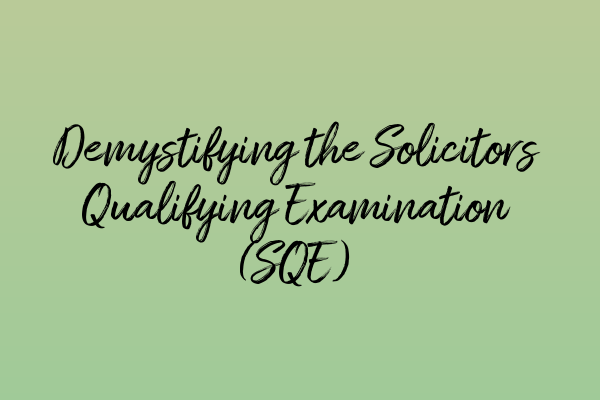Demystifying the Solicitors Qualifying Examination (SQE)
Aspiring solicitors in the United Kingdom have long been familiar with the traditional route to qualification, consisting of the Legal Practice Course (LPC) and the Training Contract. However, there is a significant change on the horizon that is set to revolutionize the process – the introduction of the Solicitors Qualifying Examination (SQE). In this blog post, we will demystify the SQE, explaining what it entails, how it differs from the current system, and what it means for future solicitors.
What is the SQE?
The SQE is a new examination framework that will replace the LPC as the final stage of qualification for solicitors in England and Wales. It is designed to ensure that all qualifying solicitors have met the same rigorous standards, regardless of the pathway they choose to reach qualification.
The SQE is divided into two stages: SQE1 and SQE2. SQE1 focuses on testing legal knowledge and is comprised of multiple choice questions and also a written task assessing practical legal skills. SQE2, on the other hand, is a skills-based assessment that requires candidates to demonstrate their competency across a range of practical legal tasks.
How does the SQE differ from the current system?
One of the key differences between the SQE and the current system is that the SQE allows for greater flexibility and accessibility. Under the traditional route, aspiring solicitors are required to complete the LPC, which can be time-consuming and costly. With the SQE, candidates can choose from a variety of pathways to qualification, including a combination of work experience and self-study, making it more accessible to a wider range of individuals.
Another significant difference is that the SQE introduces a standardized assessment process. Previously, the LPC and Training Contract were provided by various institutions, each with their own assessment methods and standards. This lack of consistency made it difficult to compare candidates from different pathways. The SQE, however, establishes a unified assessment framework, ensuring that all candidates are measured against the same criteria.
What does the SQE mean for future solicitors?
The introduction of the SQE brings both opportunities and challenges for aspiring solicitors. On one hand, the flexibility and accessibility of the SQE mean that individuals from a wider range of backgrounds will be able to pursue a career in law. This could lead to a more diverse and inclusive legal profession, which is essential for promoting equal access to justice.
On the other hand, the introduction of a new examination framework inevitably creates uncertainty and a need for preparation. Aspiring solicitors will need to familiarize themselves with the structure and content of the SQE and take the necessary steps to ensure they are adequately prepared for the assessments. This may involve undertaking additional study or seeking guidance from experienced professionals.
If you’re considering a career as a solicitor and are unsure about how the SQE will impact your journey, it’s important to seek advice from experts in the field. They can provide you with the guidance and support you need to navigate the changing landscape of legal education and qualification.
At Become Solicitor SRA, we are committed to helping aspiring solicitors succeed in their career goals. Our team of experienced solicitors can provide you with the information and support you need to navigate the process of qualification, including guidance on the SQE. Contact us today to learn more.
Related Articles:
Private Prosecutions: Exploring Non-Governmental Prosecutions in Criminal Cases
Understanding Drug-related Offences: Laws and Penalties in the UK
Magistrates’ Court vs Crown Court: Different Paths in Criminal Proceedings
Criminal Defence Strategies: Expert Approaches to Protecting Clients’ Interests
Demystifying Criminal Law Procedures: A Step-by-Step Guide


Leave a Reply